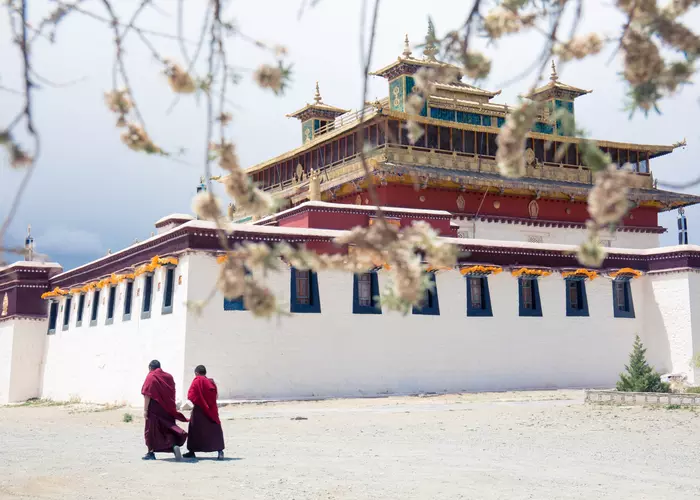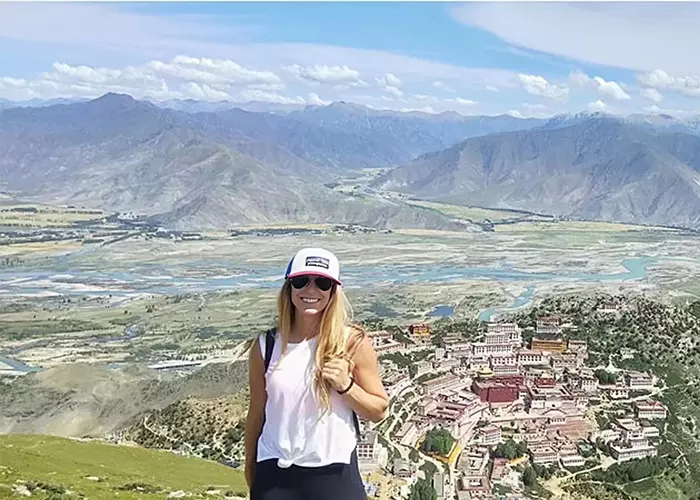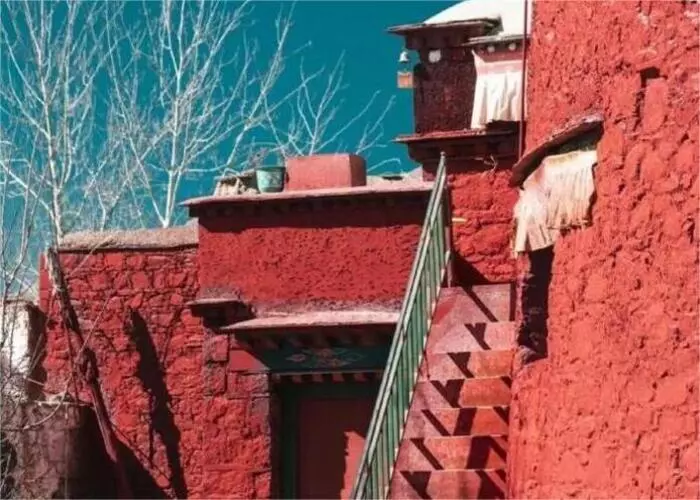Sand Mandala: A Exquisite Tibetan Buddhist Sand Art
- by Eric
- Last Updated: 2025-02-18
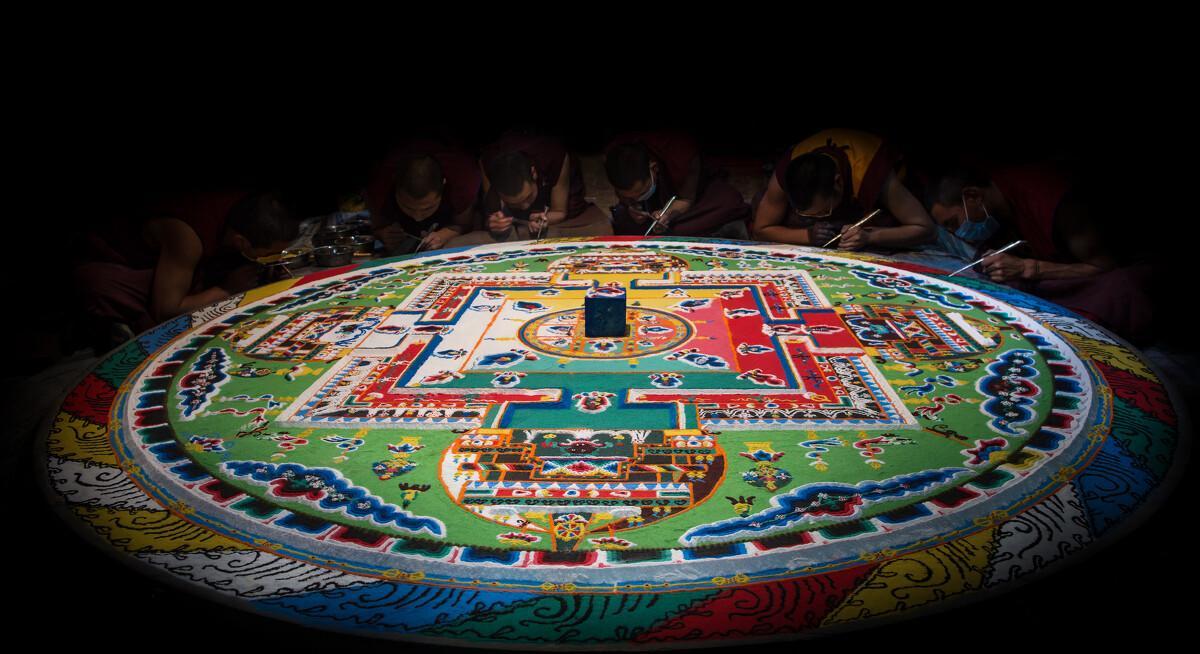
Sand Mandala is the most unique and exquisite religious art in Tibetan Buddhism. During large-scale ritual activities, the lamas in the temple use millions of sand grains to depict the grand world of the Buddhist country. This world constructed from fine sand is called a mandala, also known as "sand mandala". In the Tantric culture of Tibetan Buddhism, the sand mandala symbolizes the origin of the structure of the universe, and its center is the dwelling place of the gods. This process may last for several days or even several months. However, the precise Buddhist sand art created by the lamas with great efforts is not used to show the world its beauty. The world depicted in the sand will be swept away after a ceremony without hesitation, and it will disappear in an instant. And those sand will be put into bottles and poured into rivers.
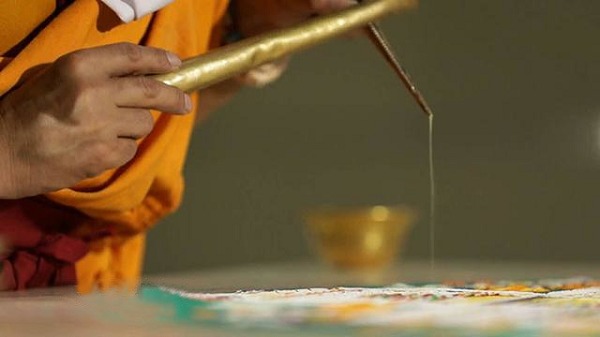 To put it simply, sand mandalas are a sacred and ancient Tibetan Buddhist art form. 'Mandala' is called dul-tson-kyil-khor in Tibetan, which means mandala of colored sand powder. In Sanskrit, Mandala means circle. If we look a little deeper into its religious linkage, 'mandala' is the term used to represent harmony and wholeness at the heart of the Tibetan Buddhist universe. It originated 2,500 years ago, the Buddha himself taught his disciples to make the altar of sand mandala. This exquisite religious art has been passed down from generation to generation. In the eleventh century, it spread from North India to Tibet and has been preserved till today.
To put it simply, sand mandalas are a sacred and ancient Tibetan Buddhist art form. 'Mandala' is called dul-tson-kyil-khor in Tibetan, which means mandala of colored sand powder. In Sanskrit, Mandala means circle. If we look a little deeper into its religious linkage, 'mandala' is the term used to represent harmony and wholeness at the heart of the Tibetan Buddhist universe. It originated 2,500 years ago, the Buddha himself taught his disciples to make the altar of sand mandala. This exquisite religious art has been passed down from generation to generation. In the eleventh century, it spread from North India to Tibet and has been preserved till today.
Content Preview
What is Tibetan Sand Mandala?
"Mandala” originated from Indian Buddhism and is used as a map where the Buddhist deities and relatives gather.
According to Tibetan Buddhism tradition, in order to prevent the intrusion of demons or non-Buddhists, practitioners used to draw a boundary circle or build an earthen altar at the practice site and set a Tathāgata statue on it. This represents Buddha and his true merits and virtues that are perfect and full without any deficiency. Later, the altar set and the boundary line were called mandalas.
The mandala paints the Buddhist ritual implements, and the deities’ palace, and the structure of the Buddha-field, constructing in three-dimensional or two-dimensional geometric shapes.
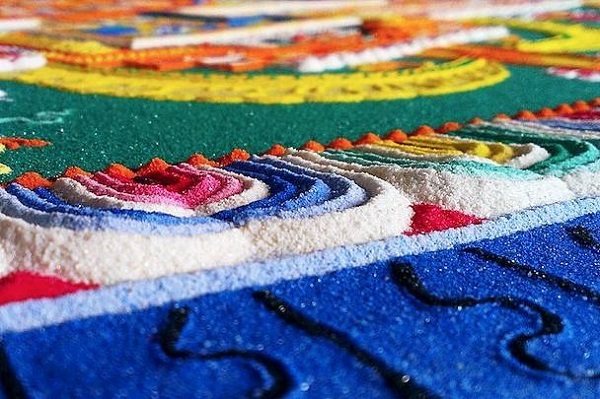 The mandala symbolizes the so-called "governance". The opposite of "governance" is "chaos". Severe weather, physical illness, desolate land, barbaric people, and non-Buddhists country are all "chaos." By building a “mandala”, which can represent almost all real or spiritual things, such as a human body, a temple, a palace, a city, a piece of land, an idea, an illusion, or a political structure, "chaos" will change to "governance". As per the above Buddhist tradition, everything in the world is generated from a mandala model, but it is just invisible to naked eyes. For example, Tibet can be considered as a "mandala" centered in Lhasa and surrounded by snow-capped mountains. Similarly, Lhasa can be considered as a “mandala” centered on the Jokhang Temple. The Jokhang Temple itself can also be considered as a “mandala” centered on the main altar. The political structure of Tibet is a "mandala" too, centered on the Dalai Lama and surrounded by other living Buddhas.
The mandala symbolizes the so-called "governance". The opposite of "governance" is "chaos". Severe weather, physical illness, desolate land, barbaric people, and non-Buddhists country are all "chaos." By building a “mandala”, which can represent almost all real or spiritual things, such as a human body, a temple, a palace, a city, a piece of land, an idea, an illusion, or a political structure, "chaos" will change to "governance". As per the above Buddhist tradition, everything in the world is generated from a mandala model, but it is just invisible to naked eyes. For example, Tibet can be considered as a "mandala" centered in Lhasa and surrounded by snow-capped mountains. Similarly, Lhasa can be considered as a “mandala” centered on the Jokhang Temple. The Jokhang Temple itself can also be considered as a “mandala” centered on the main altar. The political structure of Tibet is a "mandala" too, centered on the Dalai Lama and surrounded by other living Buddhas.
In Tibetan Buddhism Tantric practice, a mandala is an object that is commonly used for meditation. The image of the mandala becomes fully internalized and can then be summoned and contemplated at will as a clear and vivid visualized image. This mandala represents the pure surroundings of a Buddha.
According to different Buddhist tantric traditions, the structure and geometry itself, and the pattern portrayed within the mandala are different and extremely complex, tantric Buddhists afterward used gold, stone, wood, clay (soil), and sand to paint mandalas in different styles and sizes. This mandala represents the universe (cosmos). It is displayed in the Buddha Hall for the mandala-offerings, in the form of thangkas and murals. There are exquisite mandalas painted on the walls or ceilings of the Tibetan Buddhist temples. A fixed pattern with specific symbolic meaning must be respected when creating a mandala, and the specification and scale of Buddha statues are clearly stipulated, and they must not be changed to avoid reducing their sacredness.
The Significance of Tibetan Mandala
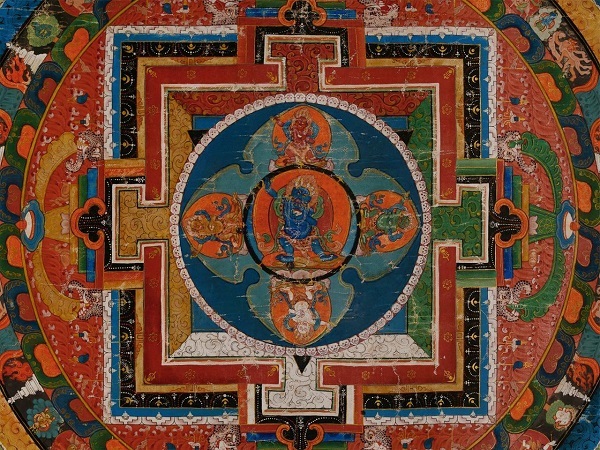 When we talk about Tibetan Buddhism, Tibet monks' sand art is one of the ancient traditions in the artistic aspect.
When we talk about Tibetan Buddhism, Tibet monks' sand art is one of the ancient traditions in the artistic aspect.
In Tibetan culture, it's believed when young children see the Buddhist sand mandala, they get positive energy. Therefore, resulting in peaceful and harmonious behavior when they grow older.
It is said that as long as you visualize the mandala, you can obtain vipassana or inner peace. If you can see the mandala, you will establish a deep relationship with the deity. The mandala can also purify the polluted environment and bring prosperity to the world.
If we go by the beliefs of Tibetan Buddhists, each Tibetan mandala has its own outer, inner, as well as secret meaning associated with it.
On the outer aspect, it's the signs of a divine form, while on the inner point, it's a way for a being to transform into an enlightened one. As for the secret level, the Tibetan sand mandala signifies an ideal balance of different energies of the body.
All these different aspects join together to purify the heart of a human being and perform healing at different levels too.
Constructing a Buddhist Sand Mandala
The process of construction of a Buddhist sand mandala is a detailed and precise one. Each step was made in accordance with the tantra taught by the Buddha, and it remains unchanged. Before using sand, the lamas usually put on masks and use special cone-shaped containers pre-filled with fine sand to control the flow through light or heavy tapping, leaking the sand on the template, and carefully stacking and delineating. The whole sand painting process must be fully focused and meticulous, and the slightest carelessness will wipe out all previous efforts.
The opening ceremony
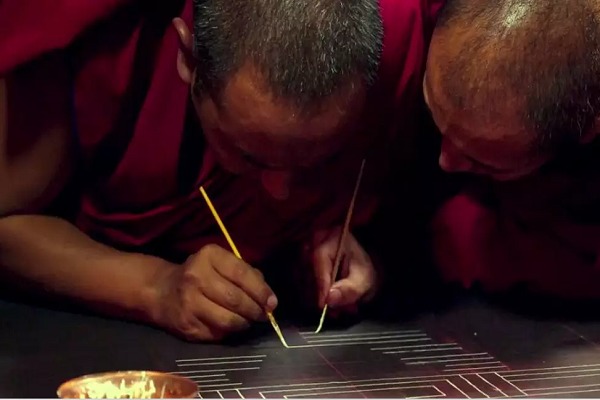 Before beginning with the design of the sand mandala, the place of construction is first consecrated by the Buddhist monks. The lamas are dressed up in ceremonies and recite different prayers, chants, and mantras. The atmosphere is solemn and mysterious, and the scene is very stunning.
Before beginning with the design of the sand mandala, the place of construction is first consecrated by the Buddhist monks. The lamas are dressed up in ceremonies and recite different prayers, chants, and mantras. The atmosphere is solemn and mysterious, and the scene is very stunning.
Drawing of the lines of the mandala
A Buddhist sand mandala is a geometrically accurate one. Therefore, the monks first draw all the geometric measurements that are associated with the creation of the sand mandala. For every sand mandala, these measurements differ. Each geometric measurement is an accumulation of precise lines and circles that can be drawn with the right proportions on the floor. Making the geometric measurements of the mandala takes about one day with multiple monks working on it. They make use of white ink pens, a compass, and a ruler to get their measurements right.
Application of colored sand
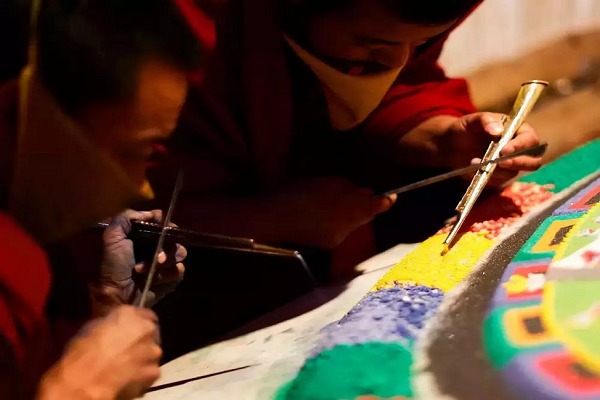 After the completion of the geometric sketch, it is time for the monks to fill in the colors. Great detail is involved in applying the colorful sand granules onto the sketch. The monks make use of very small copper tubes or funnels along with scrapers to fill in the sand of desired colors.
After the completion of the geometric sketch, it is time for the monks to fill in the colors. Great detail is involved in applying the colorful sand granules onto the sketch. The monks make use of very small copper tubes or funnels along with scrapers to fill in the sand of desired colors.
The different colors that are used in a sand mandala are designed with natural pigments from the Himalayas. These are then mixed with different pigments like red sandstone, yellow ochre, and charcoal. A few other materials used as pigments are corn meal, flower pollen, or even powdered roots or barks can be used.
The mixing of different colors results in further detailed colors for the mandala. For example, yellow and blue together make the green color. When the art first began, a mandala was not created with sand. Instead, it was dyed with natural colors. In those times, the pure granules of crushed colored stone were utilized.
Completing the sand mandala
Completing a Buddhist sand mandala with precision takes quite a few weeks. This is because there is a large amount of detail involved in its creation. There are many monks working on the same sand mandala. They work on it together and go as per different sections of the mandala to complete it timely. After the completion of the mandala, there is a special consecration ceremony held for it.
Deconstructing a sand mandala
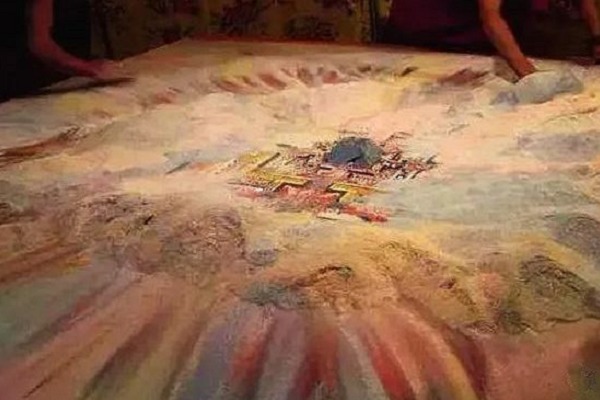 After completion of the sand mandala, it holds great significance. Therefore, it is deconstructed in a very orderly manner, too - from the outside to the inside. There is a proper ritualistic method that is accompanied by several ceremonies and prayers.
After completion of the sand mandala, it holds great significance. Therefore, it is deconstructed in a very orderly manner, too - from the outside to the inside. There is a proper ritualistic method that is accompanied by several ceremonies and prayers.
The colored sand that is removed signifies the impermanence of everything that exists on the earth. When the sand of different colors is mixed, it turns into grey-colored sand. This sand is collected in a pot that is wrapped in silk fabric. This sand is then poured into the water as a ceremonial act, and the whole world feels the energy of the sand mandala.
Four Types of Sand Mandala
The mandala can be divided into 4 types in terms of its geometric configuration of symbols, Maha Mandala, Samaya Mandala, Dharma Mandala, and Karma Mandala.
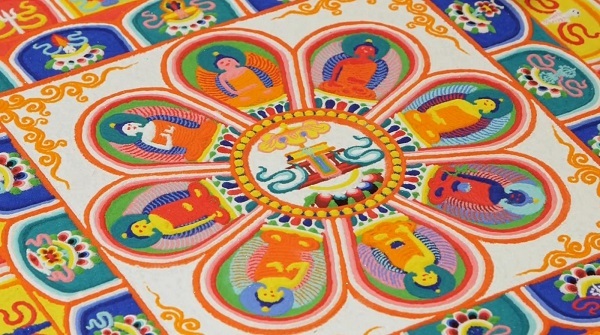 "Maha Mandala" refers to the mandala that gathers all the deities and the shapes of the deities and portrays the entire graphics and every deity image. Its colors are yellow, white, red, black, and cyan-blue, matching the five elements of Earth, Water, Fire, Wind, and Void.
"Maha Mandala" refers to the mandala that gathers all the deities and the shapes of the deities and portrays the entire graphics and every deity image. Its colors are yellow, white, red, black, and cyan-blue, matching the five elements of Earth, Water, Fire, Wind, and Void.
"Samaya Mandala" does not directly paint the images of the deities, but only depicts the symbols of deities (such as the lotus flower or sword) and the "mudra" (specific hand posture to symbolize a specific doctrine).
"Dharma Mandala" is also called the seed mandala, which represents mantras written in Sanskrit and the principles of the Chinese Buddhist canon. When a practitioner sees the first Sanskrit letter that represents the names of the Buddhas and Bodhisattvas, they worship the seed mandala as worship the Buddhas.
"Karma Mandala" depicts the virtues of the deities, as well as the statues, portraits, and clay sculptures of Buddha and Bodhisattva.
Conclusion
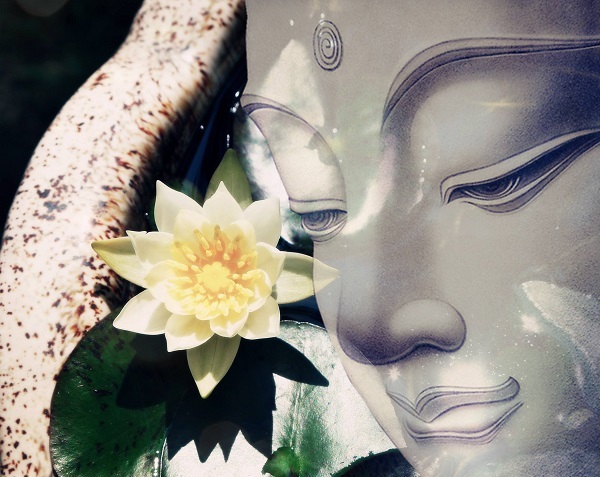 A sand mandala begins with a dot in the center. This dot represents the primary deity of the mandala. Therefore, at this central dot, a deity is drawn. During the initial drawing phase of the mandala, the outsiders do not have permission to view the ceremony or construction. The opening ceremony itself is an extensive one and involves a lot of prayer chanting, music, and dancing. Drawing a sand mandala is a highly authentic and elaborate process.
A sand mandala begins with a dot in the center. This dot represents the primary deity of the mandala. Therefore, at this central dot, a deity is drawn. During the initial drawing phase of the mandala, the outsiders do not have permission to view the ceremony or construction. The opening ceremony itself is an extensive one and involves a lot of prayer chanting, music, and dancing. Drawing a sand mandala is a highly authentic and elaborate process.
Some explain that the theme of the Sand Mandala is to show the illusion of the world. What gets destroyed is the external mandala, while the internal mandala in Lamas' mind is getting stronger. The dispersing of the sand mandala represents that all things return to its original state in the heart after death. In addition, it expresses the impermanence and emptiness of the world.
Related Articles
- Things You May Know about Tibetan Buddhism
- Tibetan Cliff and Rock Carving
- Dekang Hotel
- Tibetan Festivals
- The Gelug School of Tibetan Buddhism
- Tibetan Guide
- Tibetan Monks
- Tibetan Art
- Where is Tibet?
- Tibetan Handicrafts
Recommended Tour Packages
Email response within 0.5~24 hours.


